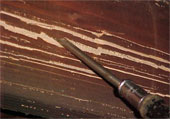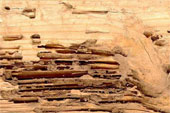Purity K-9 Termite Inspections | Termite Control
There are several types of termites but the only one found in Ontario is the Eastern Subterranean Termite. Purity Pest Control employs Canada’s only canine trained to inspect for termites and performs a passive alert (sit) when he detects the presence of termites. What does this mean? It means that Kody finds bugs that elude traditional pest inspection techniques. He doesn’t need to see them, he just needs to smell them. Traditional techniques rely on visual clues only and more times than not, they aren’t present. Our internationally recognized K-9 detection team will inspect your home or business for termites and other pests. For the best termite control call 1-905-761-9388 to schedule an appointment or submit an Inspection Request Form today!
What does a termite look like?In Canada, the Subterranean (ground nesting) Termite occurs only in British Columbia and parts of southern Ontario. In a termite colony there are 3 castes: the reproductive’s queen and king, soldiers and workers. The queen is not seen outside the centre of the colony. The soldier is brown and white with forcep-like jaws used for defending the colony, and measures 12 mm (1/2″). The worker, responsible for feeding the queen, soldiers and colony building and maintaining, measures 6 mm (1/4″). Do termites fly?At certain times of the year, yes! Depending on the size of the colony, temperature and humidity, termites will swarm. These winged termites are the future queens. After mating, the queen attempts to establish a new colony. It is strongly recommended that a professional investigate the presence of flying insects in large numbers. (Swarming is not common in Ontario.) Do termites cause damage?Yes. Termites are the most destructive of all wood-infesting insects. If proper control procedures are not carried out, serious structural damage will occur. Termites feed mainly on cellulose, a major component of wood. Continuous feeding will lead to complete destruction of the wood and your home! Yikes! When are termites most common?Since termites prefer dampness, the combination of this and warmth are ideal conditions for establishing colonies. Termites are a problem all year round. Subterranean termite colonies are found in the soil and thrive where wood is in contact with the ground. When wood is not in contact with the soil, the worker termite reaches the wood by constructing shelter (mud tubes) made of earth, excrement and saliva. Because they are sensitive to light and dryness, this tube maintains the ideal climate of moisture and temperature as well as protects them from their number one enemy, the ant. The presence of these tubes indicates that at some point there was or is a termite infestation. What are their breeding habits?During certain times of the year (usually spring), the colony, numbering in the thousands, will produce male and female winged reproductives. These winged termites leave the colony in large swarms to reproduce, with the males dying shortly after. The queens can live for up to 15 years with their only function being to lay eggs. Should the queen die, the supplementary reproductives take over this duty. Can I do anything to prevent a termite infestation on my property?Yes. By removing scrap wood from ground contact under and around buildings and by not erecting wooden structures directly touching the soil, you can minimize the risk of termite infestations. Only properly treated wood should be used in new construction. |


 Termite Control is a big is a big issue.
Termite Control is a big is a big issue.
Pingback: livingintdot.com Managed WordPress Site Toronto's dirty little secret: Termites